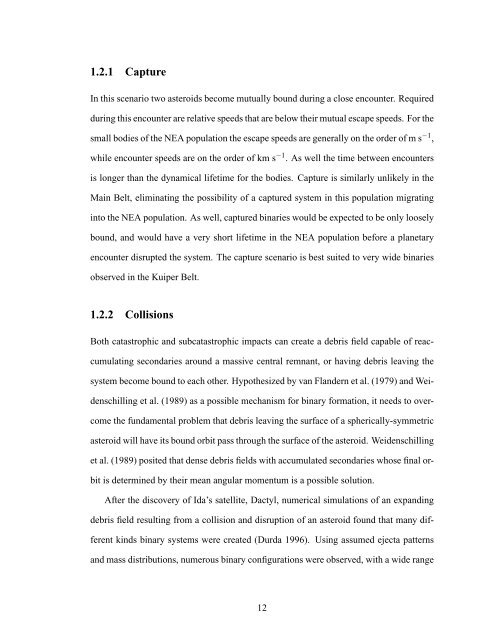Forming Binary Near-Earth Asteroids From Tidal Disruptions
Forming Binary Near-Earth Asteroids From Tidal Disruptions
Forming Binary Near-Earth Asteroids From Tidal Disruptions
You also want an ePaper? Increase the reach of your titles
YUMPU automatically turns print PDFs into web optimized ePapers that Google loves.
1.2.1 CaptureIn this scenario two asteroids become mutually bound during a close encounter. Requiredduring this encounter are relative speeds that are below their mutual escape speeds. For thesmall bodies of the NEA population the escape speeds are generally on the order of m s −1 ,while encounter speeds are on the order of km s −1 . As well the time between encountersis longer than the dynamical lifetime for the bodies. Capture is similarly unlikely in theMain Belt, eliminating the possibility of a captured system in this population migratinginto the NEA population. As well, captured binaries would be expected to be only looselybound, and would have a very short lifetime in the NEA population before a planetaryencounter disrupted the system. The capture scenario is best suited to very wide binariesobserved in the Kuiper Belt.1.2.2 CollisionsBoth catastrophic and subcatastrophic impacts can create a debris field capable of reaccumulatingsecondaries around a massive central remnant, or having debris leaving thesystem become bound to each other. Hypothesized by van Flandern et al. (1979) and Weidenschillinget al. (1989) as a possible mechanism for binary formation, it needs to overcomethe fundamental problem that debris leaving the surface of a spherically-symmetricasteroid will have its bound orbit pass through the surface of the asteroid. Weidenschillinget al. (1989) posited that dense debris fields with accumulated secondaries whose final orbitis determined by their mean angular momentum is a possible solution.After the discovery of Ida’s satellite, Dactyl, numerical simulations of an expandingdebris field resulting from a collision and disruption of an asteroid found that many differentkinds binary systems were created (Durda 1996). Using assumed ejecta patternsand mass distributions, numerous binary configurations were observed, with a wide range12












